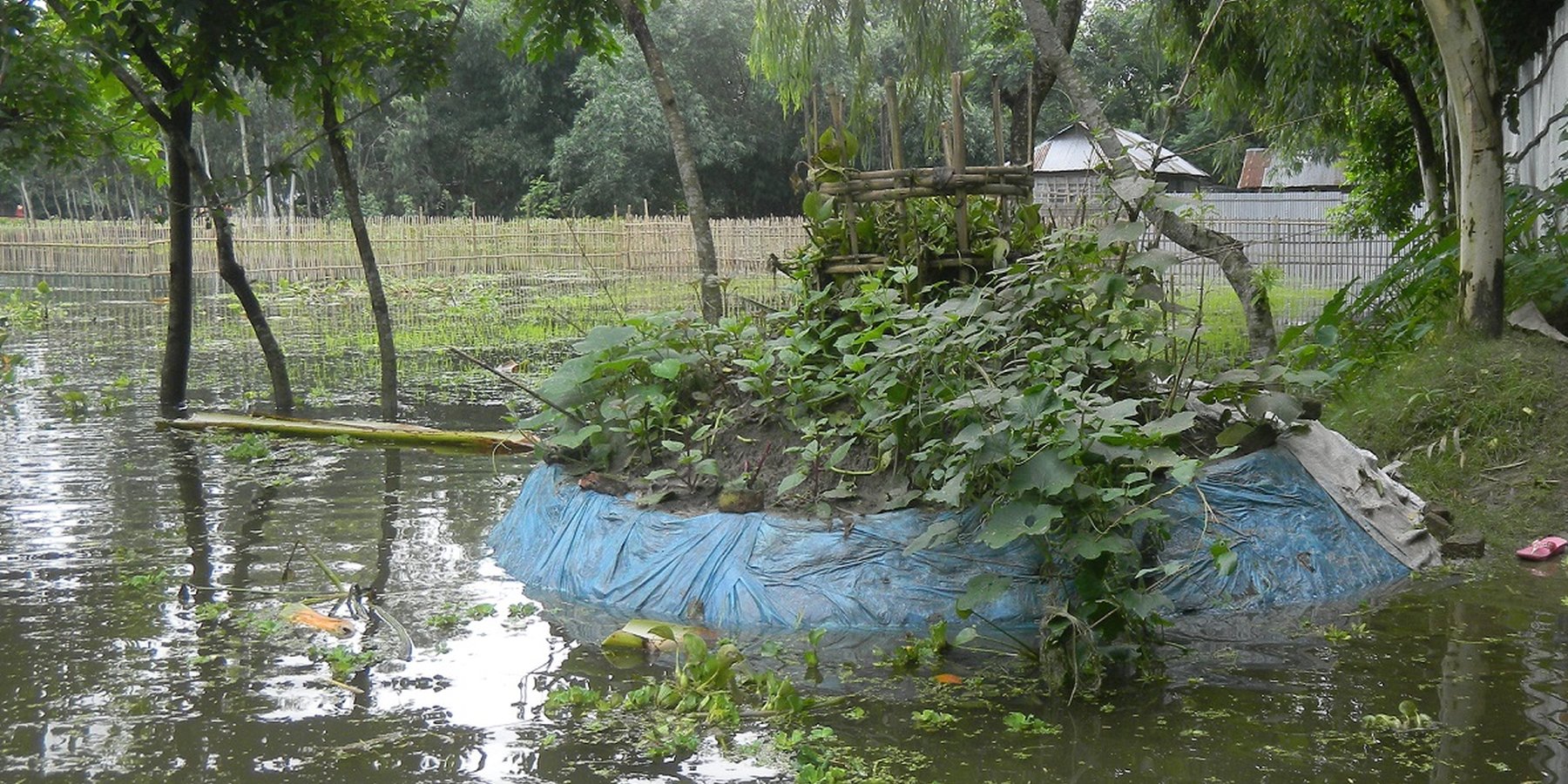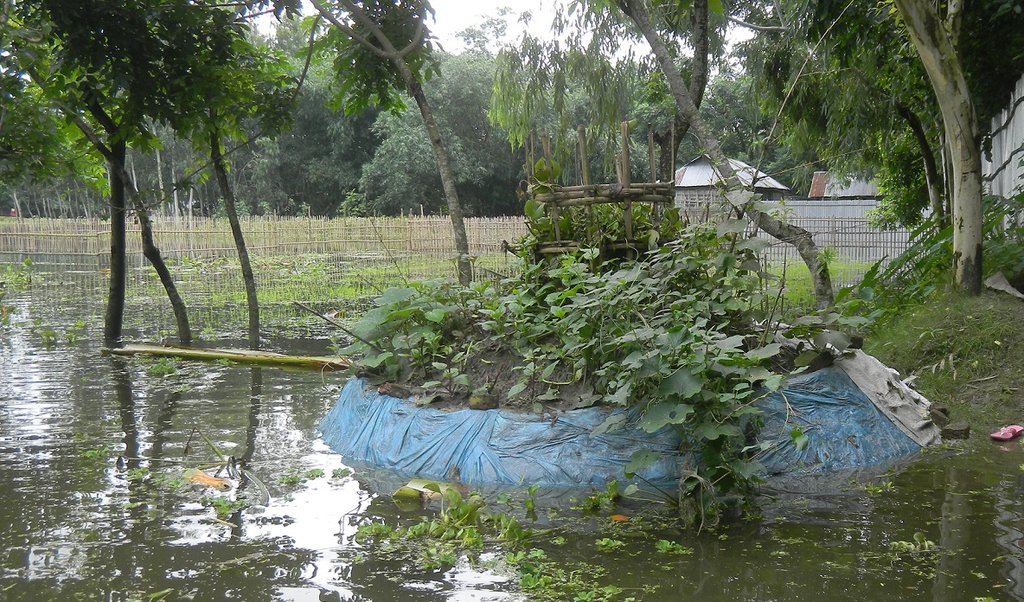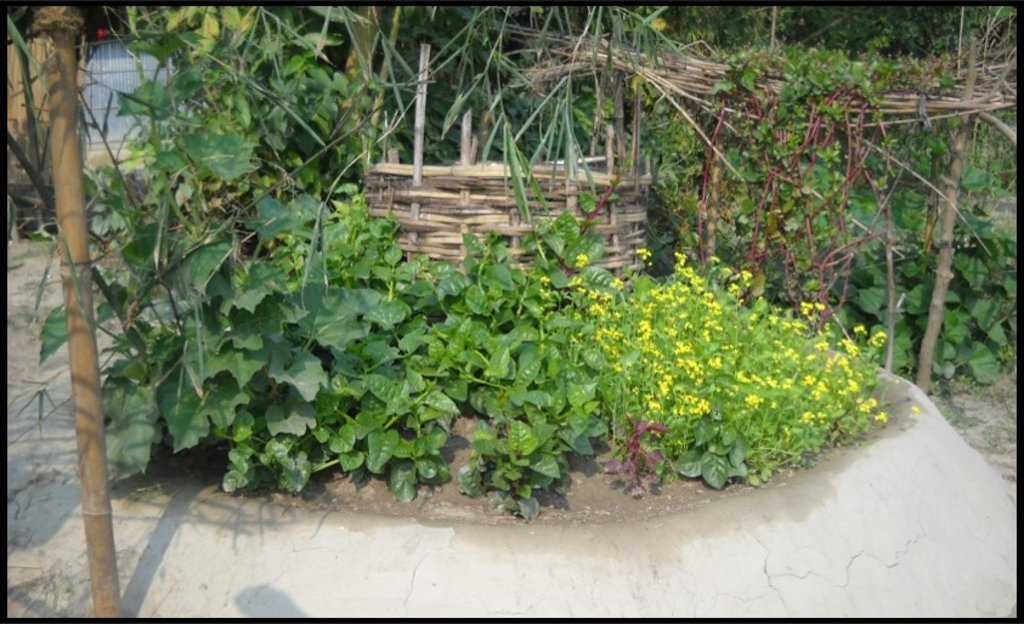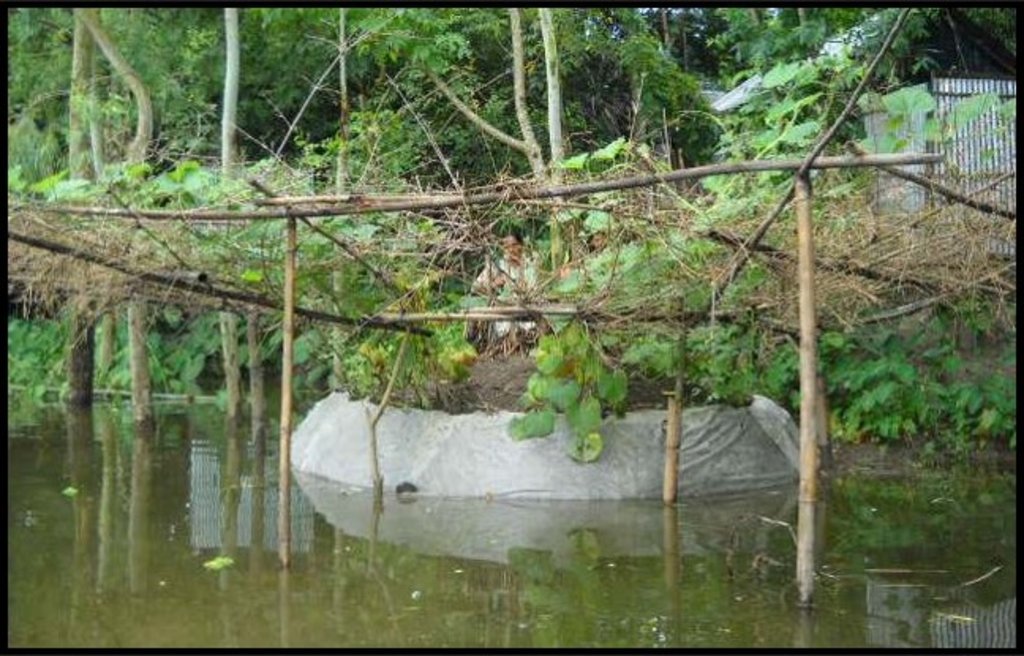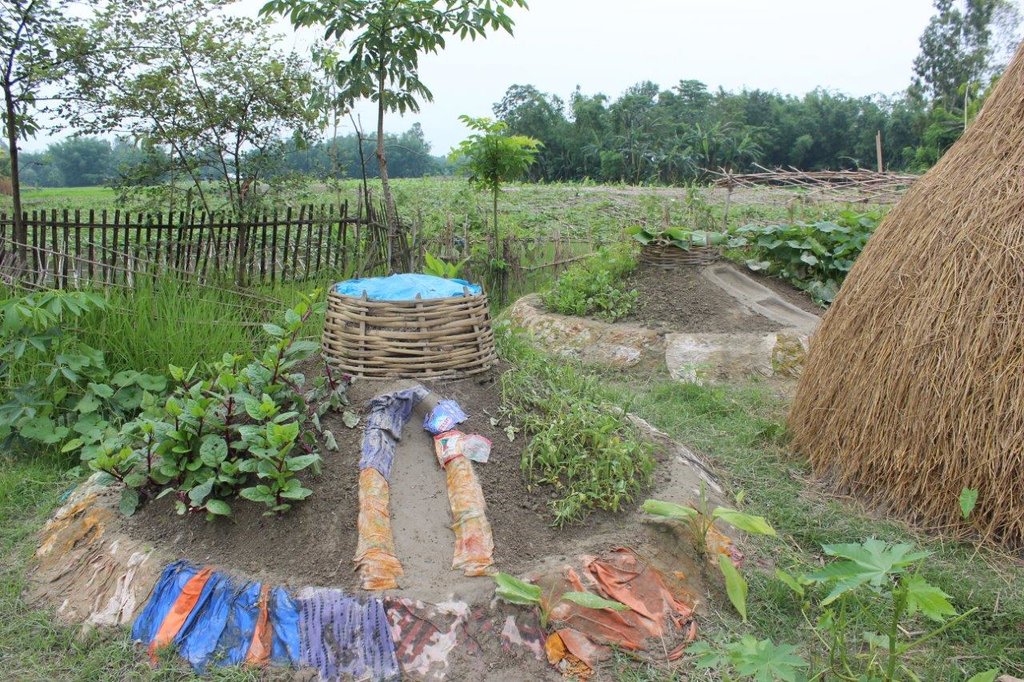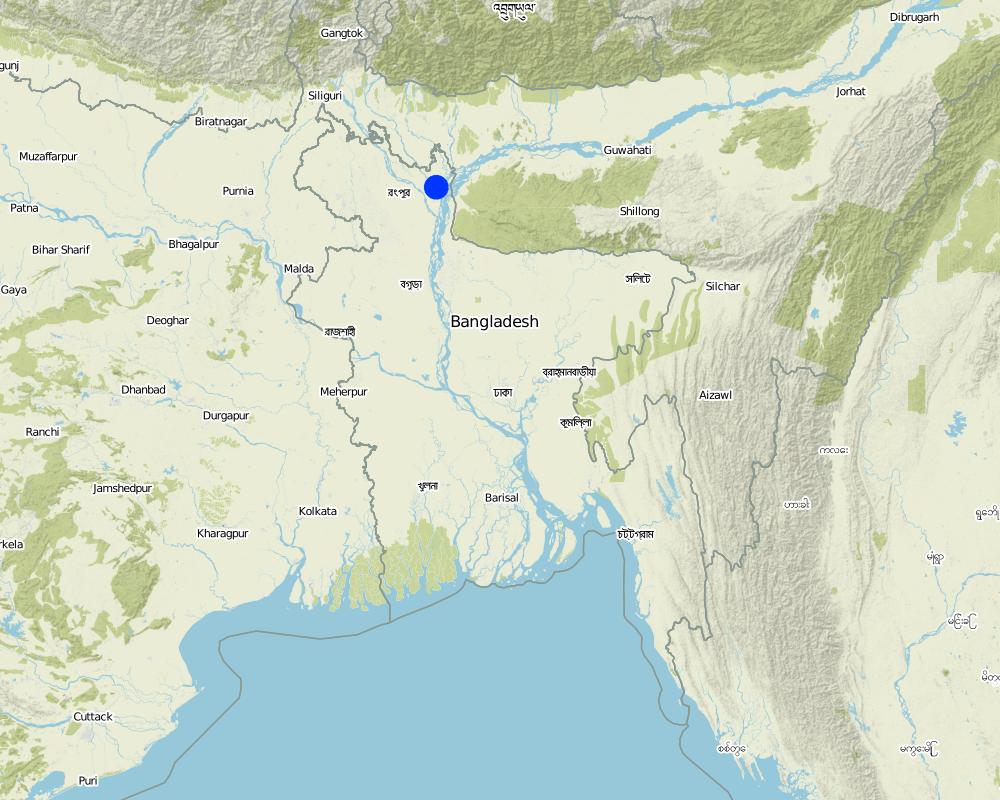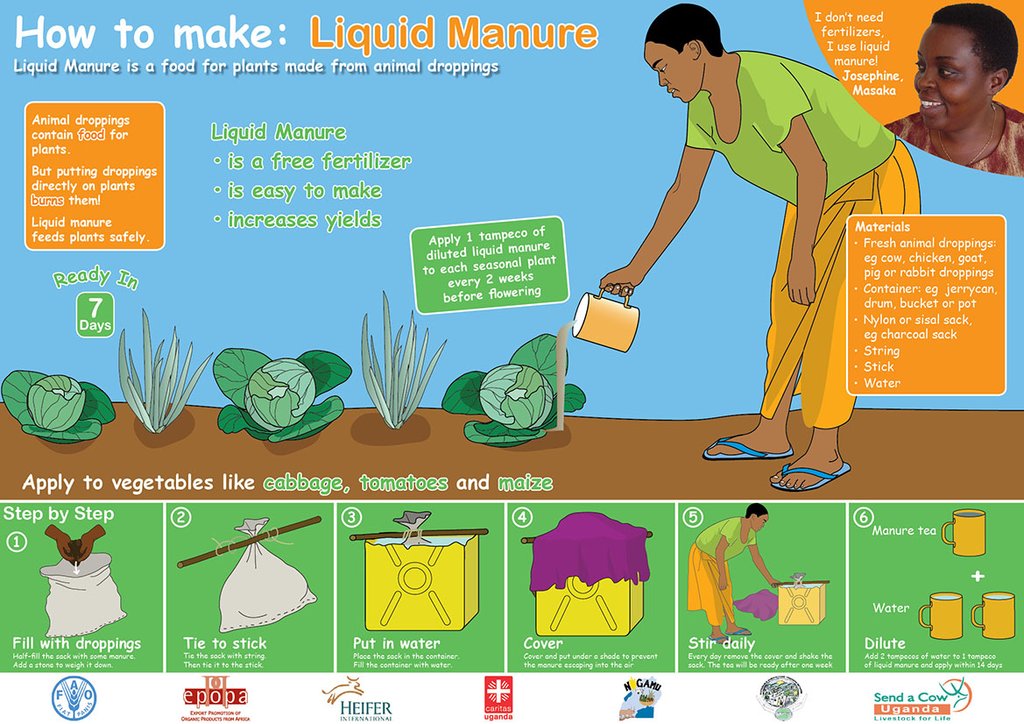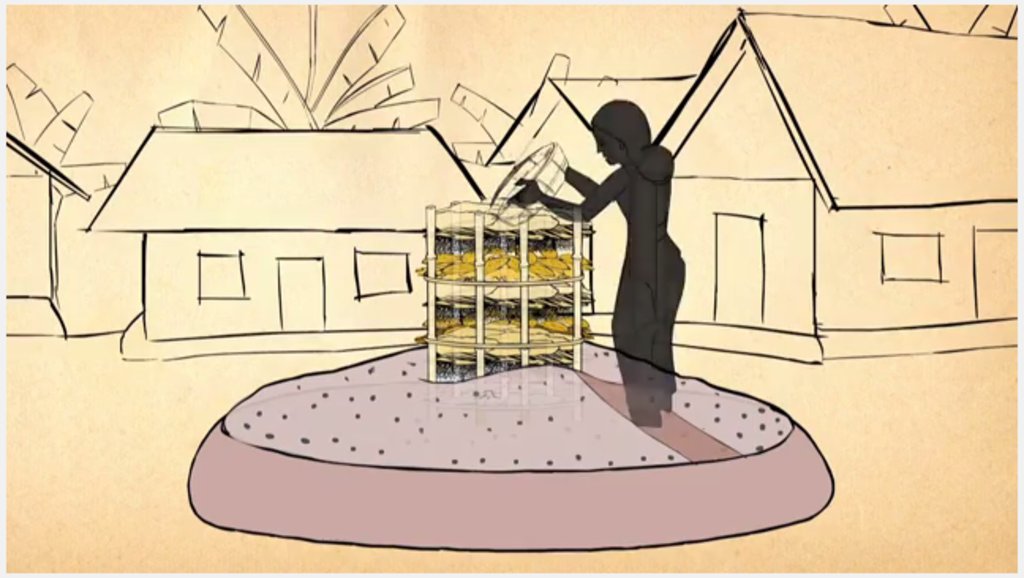Keyhole Garden [بنغلاديش]
- تاريخ الإنشاء:
- تحديث:
- جامع المعلومات: John Brogan
- المحرر: Shahid Kamal
- المراجعون: Alexandra Gavilano, Deborah Niggli, Alvin Chandra
PUSTI BAGAN ("Garden for nutrition")
technologies_779 - بنغلاديش
عرض الأقسام
توسيع الكل طي الكل1. معلومات عامة
1.2 تفاصيل الاتصال بالأشخاص الرئيسيين لمصدر المعلومات والمؤسسات المشاركة في تقييم وتوثيق التقنية
متخصص في الإدارة المستدامة للأراضي:
Varadi Daniel
daniel.varadi@greendots.ch
Greendots
www.greendots.ch
سويسرا
متخصص في الإدارة المستدامة للأراضي:
Taylor Sheila
sheila.taylor@greendots.ch
Send a Cow UK & Greendots
WASH Advisor:
اسم المشروع الذي سهّل توثيق/تقييم التقنية (إذا كان ذلك على صلة)
Book project: where people and their land are safer - A Compendium of Good Practices in Disaster Risk Reduction (DRR) (where people and their land are safer)اسم المؤسسة (المؤسسات) التي سهلت توثيق/تقييم التقنية (إذا كان ذلك على صلة)
Terre des Hommes (Terre des Hommes) - سويسرا1.3 الشروط المتعلقة باستخدام البيانات الموثقة من خلال WOCAT
متى تم تجميع البيانات (ميدانيا)؟:
02/08/2012
يوافق جامع المعلومات والشخص (لاشخاص) الرئيسي لمصدر المعلومات على الشروط المتعلقة باستخدام البيانات الموثقة من خلال WOCAT:
نعم
1.4 إعلان بشأن استدامة التقنية الموصوفة
هل التقنية الموصوفة هنا تمثل مشكلة فيما يتعلق بتدهور الأراضي، بحيث لا يمكن إعلانها تقنية مستدامة لإدارة الأراضي؟:
كلا
1.5 الإشارة إلى الاستبيان (الاستبيانات) حول مناهج الإدارة المستدامة للأراضي
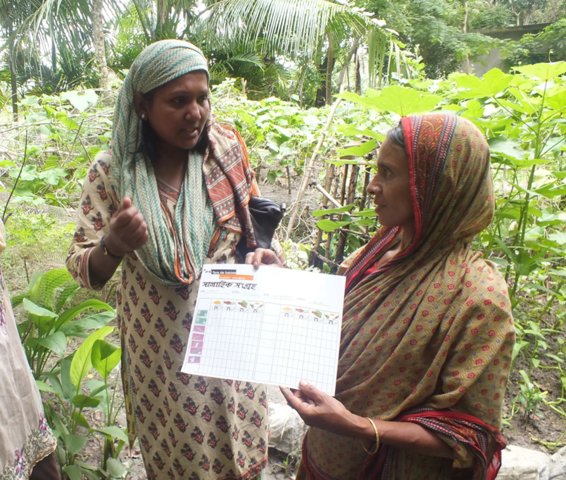
Peer to Peer Pass-on Approach with Women [بنغلاديش]
Terre des hommes and Greendots introduced the Peer to Peer pass-on system to enable women's groups in Bangladesh to spread the Keyhole Garden technique within their communities with the aim of enabling year-round homestead vegetable production despite the risk of flooding and tidal surge.
- جامع المعلومات: John Brogan
2. وصف تقنيةالإدارة المستدامي للأراضي
2.1 وصف مختصر للتقنية
تعريف التقنية:
The Keyhole Garden model of homestead vegetable cultivation enhances the resilience of families living in areas with climate-related hazards, such as flooding and drought. Keyhole gardens have been shown to increase vegetable production in all seasons, thereby improving household food autonomy and dietary diversity.
2.2 وصف تفصيلي للتقنية
الوصف:
First initiated in Ugandan communities by Send a Cow UK, the keyhole garden technique is widespread in Africa. In 2011, Terre des hommes (Tdh) and Greendots piloted Keyhole Gardens for the first time in Asia, effectively adapting the design and methodology in Africa to the conditions of flood prone areas of Bangladesh, and eventually India. The garden is a good way to enhance dietary diversity, especially for poor/landless families.
Keyhole gardens consist of a raised circular garden made of clay, shaped like a horseshoe or keyhole, with a maximum diameter of approximately three meters. For flood prone areas in Bangladesh and India, the plinth height depends on the location and is typically the same as the house plinth to resist flooding. A compost basket is built at the center of the garden. Organic matter (kitchen cuttings) and residual water are added on a regular basis through the compost pit. In some countries, bricks or stones are used to make the plinth.
The keyhole garden is a typical Low External Input Sustainable Agriculture (LEISA) approach that includes integrated composting, water retention, use of local materials, natural pest and disease control techniques, natural soil fertility measures, and proximity to the kitchen for both harvesting and care of the garden. In regions with mild conditions of flooding, tidal surge and drought, the garden increases the duration of gardening period during the year thus reducing the risk of disaster. In the aftermath of cyclone Mahasen, keyhole gardens demonstrated DRR utility: although many were partially damaged, none had to be rebuilt entirely. Where plants did not survive the storm, users were able to sow seeds immediately. On the other hand, the traditional ground-level plots used for pit and heap gardening were completely flooded / waterlogged and unusable.
Benefits of the technology include: compact size, proximity to the household for convenient maintenance and harvesting, composting of kitchen cuttings in the basket; and an ergonomic structure (raised, accessible). The small size is also ideal to facilitate training on vegetable growing, soil fertility and pest & disease management to first-time gardeners and students in schools. Keyhole gardens are highly productive—in Lesotho a typical garden can satisfy vegetable needs for a family of eight persons (FAO, 2008). Combined, these factors are scalable as an appropriate technology for landless and marginal farmers. In Bangladesh, the gardens enabled families to produce vegetables even during the monsoon period. As the keyhole garden normally does not need to be rebuilt every year it is a more efficient technique in the long-term than traditional methods such as pit and heap.
Users say that their garden produce tends to be larger and tastier than conventional gardens or market produce; and many indicated that they were able to meet their own vegetable consumption needs and to sell surplus or gift vegetables. For some women it was difficult to access sufficient amounts of soil, which meant that they needed to walk long distances to build the plinth. (Fortunately many received support from other villagers.) Secondly, during the monsoon, while most of the land is flooded, the keyhole garden remains dry. Consequently, it may provide shelter to certain animals (e.g. rats) and attract higher number of pests. Regardless of these two limitations users agree that the benefits greatly
outweigh any observed limitations.
2.3 صور التقنية
2.4 فيديوهات عن التقنية
تعليقات، وصف موجز:
https://vimeo.com/44042261
The Keyhole garden was originally developed by African farmers to preserve their crops from the wind and the sand. Locally adapted in Bangladesh in Afzal’s vegetables garden with the help of Terre des hommes staff, the Keyhole garden can also protect the crops from the heavy monsoon rain and the salt water brought by flooding and storms. These literally destroy the crops. Widely adopted, it could help in preventing malnutrition by preserving the farmer's crops.
“Two days ago, my vegetable garden was wrecked by salt water and the monsoon rains”, says Afzal, who was the first person to test the new design proposed by Tdh and its technical partner Greendots. “The storm destroyed everything – except the keyhole garden, which is intact.”
التاريخ:
14/06/2012
الموقع:
Patharghata, Barguna District, Barisal Division, Bangladesh
اسم مصور الفيديو:
Julien Lambert, Image of Dignity
2.5 البلد/المنطقة/المواقع التي تم تنفيذ التقنية فيها والتي يغطيها هذا التقييم
البلد:
بنغلاديش
المنطقة/الولاية/المحافظة:
Kurigram District / Rajshahi and Barguna District / Barisal
مزيد من التفاصيل حول الموقع:
Kurigram municipality (Kurigram), Patharghata Union (Barguna)
التعليقات:
Kurigram and Pataharghata, Bangladesh
Map
×2.6 تاريخ التنفيذ
اذكر سنة التنفيذ:
2012
2.7 إدخال التقنية
حدد كيف تم إدخال التقنية:
- من خلال ابتكار مستخدمي الأراضي
- أثناء التجارب/الأبحاث
- من خلال المشاريع/ التدخلات الخارجية
3. تصنيف تقنية الإدارة المستدامي للأراضي
3.1 الغرض الرئيسي ( الأغراض الرئيسية) للتقنية
- تحسين الإنتاج
- الحد من مخاطر الكوارث
- التكيف مع تغير المناخ/الظواهر المتطرفة وآثارها
- التخفيف من تغير المناخ وآثاره
3.2 نوع (أنواع) استخدام الأراضي الحالية حيث يتم تطبيق التقنية

الأراضي الزراعية
- Homestead Gardening
المحاصيل الرئيسية (المحاصيل النقدية والغذائية):
Winter Season: red amaranth, spinach, green chilli, tomato, eggplant, carrot, radish, onion, garlic, country bean, pumpkin, cabbage, cauliflower, broccoli.
Summer & Rainy Seasons: red amaranth, green amaranth, Indian spinach, Chinese watercress, green chili, okra, eggplant, yard long bean, bitter gourd, ash gourd, cucumber, pumpkin
3.3 مزيد من المعلومات حول استخدام الأراضي
إمدادات المياه للأرض التي يتم تنفيذ التقنية عليها:
- مختلط بعلي-مروي
عدد مواسم الزراعة في السنة:
- 3
حدد:
In Bangladesh the gardens produced in all seasons, with most challenges coming in the dry season due to soil salinity in some areas.
3.4 مجموعةالإدارة المستدامة للأراضي التي تنتمي إليها هذه التقنية
- الإدارة المتكاملة لخصوبة التربة
- الإدارة المتكاملة للآفات والأمراض (بما في ذلك الزراعة العضوية)
- حدائق منزلية
3.5 انتشار التقنية
حدد انتشار التقنية:
- يتم تطبيقها في نقاط محددة/ تتركز على مساحة صغيرة
التعليقات:
Applied in homesteads.
3.6 التدابير التقنية في مجال إلادارة المستدامة للأراضي

التدابير الزراعية
- A1: الغطاء النباتي/التربة
- A2: المادة العضوية/خصوبة التربة

التدابير البنيوية
- S11: غير ذلك
3.7 الأنواع الرئيسية من تدهور الأراضي التي تناولتها التقنية

تآكل التربة بالمياه
- الوزن(Wt): فقدان التربة السطحية/تآكل السطح
3.8 منع أو حد أو عكس تدهور الأراضي
تحديد هدف التقنية فيما يتعلق بتدهور الأراضي:
- منع تدهور الأراضي
- الحد من تدهور الأراضي
التعليقات:
See details in section 2.2
4. المواصفات الفنية، وأنشطة التنفيذ، والمدخلات، والتكاليف
4.1 الرسم الفني للتقنية
4.2 المواصفات الفنية/شروحات الرسم الفني
Gardens should be built in close vicinity to the beneficiary’s house, because gardens that are easily accessible and clearly visible are visited more regularly and maintained better.
The design is highly adaptable to local conditions and availability of free construction materials. The radius of the garden is 150CM and the delineated radius of the circular compost basket (in the center of the garden) is 45cm. The diagrams show (1) the location is near to house as an entry point for maintaining the garden; (2) the plinth is built to the same level of the house and a step is included where the plinth is high; (3) mulching to conserve the moisture; (4) interplanting a diversity of vegetables for both good vegetable health and good family nutrition; (5) using interplanted natural repellent plants as pest control for vegetables; (6) covering the basket during times of high sun intensity or heavy rain; (7) using liquid manures and plant teas as top dressing fertilisers.
Establishing what is the best height for your plinth very much depends on the local climatological conditions. In Bangladesh, the plinth is built from subsurface clayey soil, typically 2-3 feet in height - dependent on the location and level of seasonal flooding. The house plinth is a good gauge for how high to build the garden plinth. If the plinth is built too high, the roots of the plant will not be able to access sufficient water; and if built too low the next flood during the monsoon season may destroy the garden. Depending on dryness or soil/groundwater salinity, daily maintenance usually includes irrigating the soil. The outer rim of the plinth is protected with mud (and plastic or cloth) or stones. On top of the plinth is a mixture of soil and compost/manure (ratio 2:1) sloped up to the basket at a 30 - 40 degree angle. The central compost basket is filled with layers of fresh and dried vegetable matter, manure and ash to ensure that the soil fertility of the garden.
Women devised a number of different solutions to protecting the wall of the plinth and garden: Plastic bags, a combination of rice sacks (around the plinth edge) and plastic entrance way because of wear and tear (rice sacks erode faster), palm matting and old cloth. Some women put extra manure in the plinth walls to protect against flooding.
Sam Rich (www.fourthway.co.uk) has produced other technical drawings in addition to "How to Make Liquid Manure" such as: "How to make a Natural Pesticide" and "How to Make Plant Tea". There is also a version of the "How to Make a Keyhole Garden" in English from the experience in Africa.
4.3 معلومات عامة بخصوص حساب المدخلات والتكاليف
حدد كيفية احتساب التكاليف والمدخلات:
- لكل وحدة تقنية
حدد الوحدة:
Keyhole Garden
حدد العملة المستخدمة لحساب التكاليف:
- دولار أمريكي
اذكر متوسط تكلفة أجر العمالة المستأجرة في اليوم الواحد:
U.S.$2.50
4.4 أنشطة التأسيس
| النشاط | نوع التدبير | التوقيت | |
|---|---|---|---|
| 1. | Clear land; mark out basket and external boundary using rope and stick pivoted from the centre) | بنيوية أو هيكلية | Anytime |
| 2. | Build plinth (highest monsoon flood level+30cm); | بنيوية أو هيكلية | Anytime |
| 3. | Construct basket at the centre from local materials. Fill basket with composting materials; | بنيوية أو هيكلية | Anytime |
| 4. | Bring soil and heap it around the central basket. Any available animal dung can also be added into the soil mix for greater initial productivity. | بنيوية أو هيكلية | Anytime |
| 5. | Plant vegetable seeds around the garden - a mix for good family nutrition and to stop the spread of pests and diseases; | زراعية | According to the seasonal varieties |
| 6. | Mulch between plants to protect the soil. | زراعية | Anytime |
| 7. | Protect the walls with rice sacks or other waterproof protection if neccessary. | بنيوية أو هيكلية | Anytime |
4.5 التكاليف والمدخلات اللازمة للتأسيس
| تحديد المدخلات | الوحدة | الكمية | التكاليف لكل وحدة | إجمالي التكاليف لكل مدخل | % من التكاليف التي يتحملها مستخدمو الأراضي | |
|---|---|---|---|---|---|---|
| العمالة | Building the garden | person-days | 3,0 | 2,5 | 7,5 | 100,0 |
| مواد البناء | clay | 20,0 | ||||
| إجمالي تكاليف إنشاء التقنية | 7,5 | |||||
التعليقات:
Firstly, building the garden requires an initial investment in terms of labour and (locally available) inputs, such as soil and wood and clayey soil for the plinth (stones and bricks are frequently used for the plinth in Africa). These inputs are available on the homestead or in the community and generally free of cost. In rare cases families paid to have soil carted to their homestead, thus increasing the initial structural costs.
4.6 الصيانة/الأنشطة المتكررة
| النشاط | نوع التدبير | التوقيت/الوتيرة | |
|---|---|---|---|
| 1. | Weeding, harvesting, watering | إدارية | Daily |
| 2. | Structural maintenance on the garden | بنيوية أو هيكلية | Annual |
4.7 التكاليف والمدخلات اللازمة للصيانة/للأنشطة المتكررة (سنويًا)
| تحديد المدخلات | الوحدة | الكمية | التكاليف لكل وحدة | إجمالي التكاليف لكل مدخل | % من التكاليف التي يتحملها مستخدمو الأراضي | |
|---|---|---|---|---|---|---|
| العمالة | Maintenance | person-days | 11,0 | 2,5 | 27,5 | 100,0 |
| العمالة | Structural maintenance on the garden | person-days | 1,0 | 2,5 | 2,5 | 100,0 |
| مواد البناء | Earth Clay -depends on height: ex .4m plinth) | cubic meter | 11,0 | |||
| مواد البناء | Manure (quantity depends on design) | cubic meter | 2,0 | |||
| مواد البناء | Basket (sticks/bamboo with thin sticks to weave the basket | Sticks | 15,0 | |||
| مواد البناء | Protective material, rice bags/stones/plastic | Square meter | 18,0 | |||
| إجمالي تكاليف صيانة التقنية | 30,0 | |||||
التعليقات:
In Bangladesh, women referred to the time spent working on the keyhole garden as “leisure time” and that they do this work after they have completed their domestic chores. Women estimated 45 minutes daily of such activity to maintain the garden. Calling it "leisure time" is misleading, but it suggests that most women generally enjoy working in the garden and do not regard it as heavy labour. The daily wage of an agricultural labourer differs per region. In Tdh's project area, wages are relatively low, especially for women. While male labourers may earn 200 BDT ($2.50) per day, women usually earn only 90 to 150 BDT. For the calculation, we applied the principle of equal pay for equal work, taking 200BDT per day.
4.8 أهم العوامل المؤثرة على التكاليف
قدم وصفا لأهم العوامل التي تؤثر على التكاليف:
Over the last few years, people in disaster-affecteed areas of Bangladesh have become familiar to receiving during humanitarian distributions; and expect “hand-outs” if they were to participate in a development project. The Keyhole garden project, however, follows the LEISA approach and does not rely on giving free inputs to the participants. (In a few cases where the local population was lacking seeds and experience in seed production, women's groups were given seeds and training.) A lack of reliance on external inputs or subsidies contributes to the sustainability of the project. The inputs (clay, manure, sticks, rocks, etc.) are locally available and usually do not require additional expenses. This may not be the case in all contexts.
5. البيئة الطبيعية والبشرية
5.1 المناخ
هطول الأمطار السنوي
- < 250 مم
- 251- 500 ملم
- 501 - 750ملم
- 1,000-751 ملم
- 1,500-1,100 ملم
- 2,000-1,500 ملم
- 3,000-2,001 ملم
- 4,000-3,100 ملم
- > 4000 ملم
حدد متوسط هطول الأمطار السنوي (إذا كان معروفًا)، بالملليمتر:
2666,00
المواصفات/التعليقات على هطول الأمطار:
Applied in areas with monsoon and drought like conditions in the project areas in Bangladesh.
الإشارة إلى اسم محطة الأرصاد الجوية المرجعية المعنية:
http://data.worldbank.org/indicator/AG.LND.PRCP.MM
المنطقة المناخية الزراعية
- رطبة
- شبه رطبة
- شبه قاحلة
The technology is adapted to semi-arid areas/countries in Africa like Uganda and Tanzania.
5.2 طوبوغرافيا
متوسط الانحدارات:
- مسطح (0-2%)
- بسيط (3-5%)
- معتدل (6-10%)
- متدحرج (11-15%)
- تلال (16-30%)
- شديدة الانحدار(31-60%)
- فائقة الانحدار (>60%)
التضاريس:
- هضاب/سهول
- أثلام مرتفعة
- المنحدرات الجبلية
- منحدرات التلال
- منحدرات في السفوح
- قاع الوادي
المنطقة الارتفاعية:
- 100-0 متر فوق سطح البحر
- 500-101 متر فوق سطح البحر
- 1,000-501 متر فوق سطح البحر
- 1,500-1,001 متر فوق سطح البحر
- 2,000-1,501 متر فوق سطح البحر
- 2,500-2,100 متر فوق سطح البحر
- 3,000-2,501 متر فوق سطح البحر
- 4,000-3,001 متر فوق سطح البحر
- > 4000 متر فوق سطح البحر
وضح ما إذا كانت التقنية مطبقة على وجه التحديد في:
- غير ذات صلة
5.3 التربة
متوسط عمق التربة:
- ضحل جدًا (0-20 سم)
- ضحلة (21-50 سم)
- متوسطة العمق (51-80 سم)
- عميقة (81-120 سم)
- عميقة جدًا (> 120 سم)
قوام التربة (التربة السطحية):
- ناعم/ثقيل (طيني)
قوام التربة (> 20 سم تحت السطح):
- ناعم/ثقيل (طيني)
المواد العضوية في التربة السطحية:
- متوسطة (1-3%)
5.4 توافر المياه ونوعيتها
منسوب المياه الجوفية:
< 5 م
توافر المياه السطحية:
زائدة
نوعية المياه (غير المعالجة):
مياه الشرب سيئة (تتطلب معالجة)
هل تعتبر ملوحة الماء مشكلة؟:
نعم
حدد:
In project sites along the Bay of Bengal
هل تحدث فيضانات في المنطقة؟:
نعم
الإنتظام:
مرارًا
5.5 التنوع البيولوجي
تنوع الأنواع:
- منخفض
تنوع الموائل:
- متوسط
5.6 خصائص مستخدمي الأراضي الذين يطبقون التقنية
مستقر أو مرتحل:
- غير المترحل
التوجه السوقي لنظام الإنتاج:
- الكفاف (الإمداد الذاتي)
- مختلط (كفاف/ تجاري)
الدخل من خارج المزرعة:
- أقل من % 10من كامل الدخل
- 10-50% من جميع الإيرادات
المستوى النسبي للثروة:
- ضعيف جدا
- ضعيف
أفراداً أو مجموعات:
- فرد/أسرة معيشية
مستوى المكننة:
- عمل يدوي
- الجر الحيواني
الجنس:
- نساء
- رجال
عمر مستخدمي الأرضي:
- متوسط العمر
اذكر الخصائص الأخرى ذات الصلة لمستخدمي الأراضي:
Using a methodology called the problem tree analysis it is understood that the people living in the two working areas regularly experience health-related problems, economic challenges, and agricultural difficulties.
5.7 متوسط مساحة الأرض المملوكة أو المستأجرة من قبل مستخدمي الأراضي الذين يطبقون التقنية
- < 0.5 هكتارا
- 0.5 - 1 هكتار
- 1 -2 هكتار
- 2 - 5 هكتار
- 5 - 15 هكتار
- 15 - 50 هكتار
- 50 - 100هكتار
- 500-100 هكتار
- 1,000-500 هكتار
- 10,000-1,000 هكتار
- > 10,000 هكتار
هل يعتبر هذا نطاقًا صغيرًا أو متوسطًا أو واسعا (في إشارة إلى السياق المحلي)؟:
- على نطاق صغير
التعليقات:
The majority of the project beneficiaries are "landless" having access to small homestead areas and without cropland. Most households have access to small (< 16 decimal) or very small (< 6 decimal) homestead areas.
5.8 ملكية الأراضي، وحقوق استخدام الأراضي، وحقوق استخدام المياه
ملكية الارض:
- فردية، لا يوجد سند ملكية
حقوق استخدام الأراضي:
- فردي
حقوق استخدام المياه:
- وصول مفتوح (غير منظم)
5.9 الوصول إلى الخدمات والبنية التحتية
الصحة:
- ضعيف
- معتدل
- جيد
التعليم:
- ضعيف
- معتدل
- جيد
المساعدة التقنية:
- ضعيف
- معتدل
- جيد
العمل (على سبيل المثال خارج المزرعة):
- ضعيف
- معتدل
- جيد
الأسواق:
- ضعيف
- معتدل
- جيد
الطاقة:
- ضعيف
- معتدل
- جيد
الطرق والنقل:
- ضعيف
- معتدل
- جيد
مياه الشرب وخدمات الصرف الصحي:
- ضعيف
- معتدل
- جيد
الخدمات المالية:
- ضعيف
- معتدل
- جيد
6. الآثار والتصريحات الختامية
6.1 الآثار التي أظهرتها التقنية في الموقع
الآثار الاجتماعية والاقتصادية
الإنتاج
إنتاج المحاصيل
الكمية قبل الإدارة المستدامة للأراضي:
<5% of pilot families growing vegetables in all 3 seasons
الكمية بعد الإدارة المستدامة للأراضي:
50% of the pilot families able to grow vegetables in 3 seasons
التعليقات/ حدد:
Before the project started, the majority of the participants were not able to produce vegetables year round. Especially during the monsoon months, people were dependent on produce available at the local market. The baseline survey indicated that in both regions more than 50% of the households would cultivate vegetables for a maximum of 3 months per year and in Kurigram 30% of the participants were not able to grow vegetables at all.
This situation has changed significantly after the introduction of the keyhole gardens. At least 50% of the households were able to produce vegetables during each season. Where in the past almost no one was able to cultivate during the monsoon period, now on average 63% of the households in Kurigram and 73% of the households in Patharghata were growing vegetables in the wet season.
The summer figures are actually lower than the monsoon figures. Seeds did not germinate well, because participants were not fully prepared to deal with the dry and saline conditions during this season. Learning from this experience, and with adequate support from Tdh, participants should be able to achieve higher cultivation rates in the future.
تنوع المنتج
الكمية قبل الإدارة المستدامة للأراضي:
Average of 2-4 types of vegetables grown.
الكمية بعد الإدارة المستدامة للأراضي:
Average of six types of vegetables grown
التعليقات/ حدد:
During the field visits and individual interviews in June 2013, the majority of the participants indicated that in the keyhole garden they usually grow 6 or more different types of vegetables at any given time. This is a marked difference from previous years, when the majority of people in Patharghata would only grow 2 types of vegetables. In Kurigram the baseline was somewhat higher (31% cultivated 4 types of vegetables per year on average), but still significantly lower than in 2013. By increasing the different types of vegetables grown, the families have access to a more diversified diet.
منطقة الإنتاج
الكمية قبل الإدارة المستدامة للأراضي:
0
الكمية بعد الإدارة المستدامة للأراضي:
333
التعليقات/ حدد:
In addition to the 175 pilot keyhole gardens, an additional 158 gardens were started on homesteads either via peer to peer pass-along system or spontaneous copy/replication of the technology.
الآثار الاجتماعية والثقافية
الوضع الصحي
التعليقات/ حدد:
The Keyhole Garden supports a diversified diet by enabling year-round vegetable production; thus boosting the resilience of homesteads exposed to extreme weather patterns (drought or monsoon/flood seasons).
وضع الفئات المحرومة اجتماعيا واقتصاديا
التعليقات/ حدد:
Gardens will quickly increase household vegetable production, easing economic burden and providing for the household consumption or surplus to sell or gift. The latter can increase social bonding and benefit peer to peer linkages.
Teaching
التعليقات/ حدد:
Keyhole garden building and maintenance teaches lessons of good soil, water and vegetable management that can be transferred to field crops or plain large scale vegetable growing.
الآثار الايكولوجية
التربة
فقدان التربة
التعليقات/ حدد:
Precious topsoil is not lost during flooding events.
الحد من مخاطر المناخ والكوارث
آثار الفيضانات
التعليقات/ حدد:
Gardens that are not submerged by floods continue to produce in the monsoon season.
الآثار الايكولوجية الأخرى
Surpluses can be used for selling or gifting; increased vegetables especially at times when they are not usually available enables families to save money on expensive purchases out of the normal vegetable season
6.2 الآثار التي أظهرتها التقنية خارج الموقع
Teaching
التعليقات/ حدد:
Keyhole garden building and maintenance teaches lessons of good soil, water and vegetable management that can be transferred to field crops or plain large scale vegetable growing.
6.3 تعرض التقنية وحساسيتها لتغير المناخ التدريجي والظواهر المتطرفة/الكوارث المرتبطة بالمناخ (كما يراها مستخدمو الأراضي)
الظواهر المتطرفة / الكوارث المرتبطة بالمناخ
الكوارث الجوية
| كيف تتعامل التقنية مع ذلك؟ | |
|---|---|
| عاصفة إستوائية | باعتدال |
| عاصفة رعدية محلية | جيدا |
الكوارث الهيدرولوجية
| كيف تتعامل التقنية مع ذلك؟ | |
|---|---|
| فيضان عام (نهر) | جيدة جدا |
| هبوب العواصف / الفيضانات الساحلية | جيدا |
العواقب الأخرى المتعلقة بالمناخ
العواقب الأخرى المتعلقة بالمناخ
| كيف تتعامل التقنية مع ذلك؟ | |
|---|---|
| انخفاض فترة النمو | جيدة جدا |
6.4 تحليل التكلفة والعائد
كيف يمكن مقارنة العوائد نسبة لتكاليف الإنشاء (من وجهة نظر مستخدمي الأراضي)؟
عوائد قصيرة الأجل:
ايجابي جدا
كيف تتم مقارنة العوائدمع كلفة الصيانة/التكاليف المتكررة (من وجهة نظر مستخدمي الأراضي)؟
عوائد قصيرة الأجل:
ايجابي جدا
التعليقات:
No long term study available.
In most cases no (or very low) investment cost in materials and a low investment cost in labor was necessary. Thus the establishment and maintenance costs are relatively low compared to the benefit of increased homestead vegetable production and access to produce for increasing dietary diversity. The benefit increases when the technology supports resilience to flooding as was the case from flooding (Kurigram), and partially from a cyclone (Patharghata).
6.5 اعتماد التقنية
- أكثر من 50%
إذا كان متاحًا، قم بتحديد الكمية (عدد الأسر المعيشية و/أو المساحةالمغطاة):
333 from the pilot study. Subsequent projects by Tdh from 2013-2015 have seen over 3'500 keyhole gardens created in Bangladesh and India.
من بين جميع الذين تبنوا التقنية، كم عدد الذين فعلوا ذلك بشكل تلقائي، أي دون تلقي أي حوافز مادية/مدفوعات؟:
- 100-90%
التعليقات:
All of the adopters did so with training but without inputs. Spontaneous adoption of the Keyhole Garden without training is not easy to measure, but Tdh's experience shows a conservative average of 11% (38 of 333 gardens).
6.6 التكيف
هل تم تعديل التقنية مؤخرًا لتتكيف مع الظروف المتغيرة؟:
نعم
إذا كانت الإجابة بنعم، وضح الظروف المتغيرة التي تم تكييفها معها:
- تغير المناخ / التطرف
حدد تكيف التقنية(التصميم، المواد/الأنواع، الخ.):
The technology was adapted from semi-arid zones in Africa (where soil amelioration and water conservation were priorities and materials such as stones and brick are available) to areas of South Asia prone to flood and tidal surge.
6.7 نقاط القوة / المزايا / الفرص التي توفرها التقنية
| نقاط القوة/ المزايا/ الفرص من وجهة نظر مستخدمي الأراضي |
|---|
|
Seasonal local agriculturalists reported that gardens yielded high productivity with good vegetable quality and diversity; withstood heavy monsoon rains lasting for several days; and withstood a salt water tidal intrusion that destroyed adjacent traditional gardens. During the FGDs women clearly expressed a lot of enthusiasm for the project and all the participants indicated that they would continue with their garden, even if Tdh would no longer provide any support. One volunteer reported successfully harvesting five common vegetables usually impossible to grow in monsoon conditions: - In plain land we can cultivate once in a year but in keyhole garden we can harvest vegetables in three seasons and they don't go underwater in the rainy season - Save money for the family: don't need to buy fertilizers or vegetables and some people earn money by selling the garden product - We can collect vegetables for the children’s requirements directly from the garden when they need them - In a small space you can have lots of different vegetables and the taste is much better because the garden depends on compost – no chemicals - The cost to make is it very low, but you need labour; by our own labour we can build it - Because of composting the garden can always get nutrients |
| نقاط القوة/ المزايا/ الفرص من وجهة نظر جامع المعلومات أو غيره من الاشخاص الرئيسيين لمصدر المعلومات |
|---|
|
The keyhole garden project has been very successful and has largely achieved its core objective to improve year-round access to nutritious food from the homestead area. These benefits are summarized again as: - Appropriate size for landless homesteads, also ideal to facilitate training on LEISA techniques to first-time gardeners and students in schools. - Proximity to the household for convenient maintenance and harvesting, composting of kitchen cuttings in the basket; - Ergonomic structure (raised, accessible). - Highly adaptable to local conditions that supports resilience to flood and drought conditions. - Highly productive—families produced vegetables even during the monsoon period. - As the keyhole garden normally does not need to be rebuilt every year it is a more efficient technique in the long-term than traditional methods such as pit and heap. Therefore, the reviewer did not suggest any major changes to the technique or project; rather to focus on specific issues that could help making the project more efficient and that could help broaden its impact. |
6.8 نقاط ضعف / مساوىء / مخاطر التقنية وسبل التغلب عليها
| نقاط الضعف/ المساوىء/ المخاطر من وجهة نظر مستخدم الأراضي | كيف يمكن التغلب عليها؟ |
|---|---|
|
No major weaknesses in the technology or design were expressed. However for some women it was difficult to access sufficient amounts of soil, which meant that they needed to walk long distances to bring soil to build the plinth. In coastal areas where saline intrusion in groundwater and soils is on the rise, growing and irrigating crops is difficult in the dry season. |
Some women received support from other family members or neighbours; identify a support network for families having challenges to access soil to build the plinths. Continue to look for for alternative irrigation sources and/or groundwater recharge innovations as well as soil conservation techniques to protect against salinity. Likewise, saline resistant vegetable varieties may be available. |
| نقاط الضعف/ المساوىء/ المخاطر من وجهة نظر جامع المعلومات أو غيره من الاشخاص الرئيسيين لمصدر المعلومات | كيف يمكن التغلب عليها؟ |
|---|---|
|
More careful planning of the location for the keyhole garden is needed. In Patharghata 11 women decided to relocate their garden within the first year. This suggests that the women appreciate the benefits of the garden, but having to break down and move the garden is a rather laborious activity. Not surprisingly, women who have less time to work in the homestead area, e.g. due to work or other out-of-home responsibilities, are not able to maintain their keyhole garden so well. |
Spend more time to assist the participants with identifying the most suitable locations to construct the garden for a keyhole garden in the homestead area at the start of the project. While maintaining a focus on women, involve the husband or other family members/ neighbours and ensure that they are also trained and ensure that the garden is clearly visible and can be accessed. |
7. المراجع والروابط
7.1 طرق جمع/مصادر المعلومات
- زيارات ميدانية، مسوحات ميدانية
50: The project evaluation took place from 4 June to 12 June 2013 with field visits in the two project areas, Kurigram and Patharghata. In total 5 Focus Group Discussions (FGD), with approximately 10 participants per FGD, were organized during this period. The core objective of the FGDs was to assess whether keyhole gardens have contributed to increases in vegetable production throughout the year and if this has lead to improved consumption practices. The additional aim of the FGDs was to learn directly from the participants about their nutritional needs and their ideas to further improve the keyhole garden project.
- مقابلات مع مستخدمي الأراضي
8: In addition to the FGDs the consultant carried out eight individual interviews with project
participants from the two regions. The individual interviews provided more detailed
information about production techniques and about the impact of the project at the
household level.
- التجميع من التقارير والوثائق الأخرى الموجودة
Al-Amin S, 2012 and 2013, Tdh Bangladesh, Monthly Situation Reports for Garden Projects (unpublished)
Taylor S, 2013, Discussion paper for the Agrobiodiversity Conference, Dhaka, 28 January
2013, “Keyhole Gardens – great potential for improving homestead crop diversity and
mother & child nutrition”
Taylor S, 2012, Tdh Bangladesh, Project Report Homestead Garden for Greendots (unpublished)
Van Hout, 2013, Keyhole Gardens: Improved Access to Homestead Vegetables and Dietary Diversification, External Evaluation and Capitalization of the Keyhole Garden Project in Bangladesh (unpublished)
Varadi D, 2011, Tdh Bangladesh Field Visit Report for Greendots (unpublished)
7.2 المراجع للمنشورات المتاحة
العنوان، المؤلف، السنة، النظام القياسي الدولي لترقيم الكتب ISBN:
"Keyhole Gardens: Improved Access to Homestead Vegetables and Dietary Diversification- External Evaluation and Capitalization of the Keyhole Garden Project in Bangladesh", Van Hout, R., 2013
متاح من أين؟كم التكلفة؟:
Freely available: Terre des hommes Lausanne Asia Desk: info@tdh.ch
العنوان، المؤلف، السنة، النظام القياسي الدولي لترقيم الكتب ISBN:
“Keyhole Gardens – great potential for improving homestead crop diversity and mother & child nutrition”, Taylor S, 2013, Discussion paper for the Agrobiodiversity Conference, Dhaka, 28 January 2013
متاح من أين؟كم التكلفة؟:
Freely available: Terre des hommes Lausanne Asia Desk: info@tdh.ch
العنوان، المؤلف، السنة، النظام القياسي الدولي لترقيم الكتب ISBN:
"Keyhole Gardens in Lesotho", FAO Nutrition and Consumer Protection Divis"ion (AGN), 2008 (with Send a Cow UK)
متاح من أين؟كم التكلفة؟:
http://www.fao.org/ag/agn/nutrition/docs/FSNL%20Fact%20sheet_Keyhole%20gardens.pdf
7.3 روابط للمعلومات ذات الصلة المتوفرة على الإنترنت
العنوان/الوصف:
Greendots - Terre des hommes technical partner for Keyhole Gardens in South Asia
عنوان الرابط URL:
www.greendots.ch
العنوان/الوصف:
Send a Cow UK: How to make an African style raised bed (YouTube, ex. Uganda)
عنوان الرابط URL:
https://www.youtube.com/watch?v=ykCXfjzfaco
العنوان/الوصف:
Send a Cow UK - Keyhole Garden resources (Learning from Africa: How to make a Keyhole Garden)
عنوان الرابط URL:
http://www.sendacow.org.uk/lessonsfromafrica/resources/keyhole-gardens
العنوان/الوصف:
Fourthway's posters online: Smallholder organic agriculture (Uganda, including Keyhole gardens)
عنوان الرابط URL:
http://www.fourthway.co.uk/posters/
العنوان/الوصف:
Fourthway's posters online: Smallholder organic agriculture (Bangladesh, including Keyhole gardens)
عنوان الرابط URL:
http://www.fourthway.co.uk/bangladesh/index.html
العنوان/الوصف:
Terre des hommes: First Keyhole Garden in Asia (to resist storm surge/floods in Bangladesh)
عنوان الرابط URL:
https://vimeo.com/44043929
الروابط والوحدات المواضيعية
توسيع الكل طي الكلالروابط

Peer to Peer Pass-on Approach with Women [بنغلاديش]
Terre des hommes and Greendots introduced the Peer to Peer pass-on system to enable women's groups in Bangladesh to spread the Keyhole Garden technique within their communities with the aim of enabling year-round homestead vegetable production despite the risk of flooding and tidal surge.
- جامع المعلومات: John Brogan
الوحدات المواضيعية
لا يوجد وحدات مواضيعية


